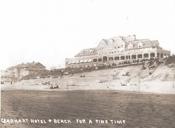History
In 1848, Phillip Gearhart, eponymous father of the city of Gearhart, set out from Independence, Missouri with his family and arrived in Oregon City in October of that year. He then rented a log cabin on Clatsop Plains. Farmers had already somewhat settled The Plains (primarily at the north end). The first farmer to settle there was Solomon Smith. He arrived in [Gearhart Train Depot] 1832 and married the daughter of Cobaway, chief of the Clatsops. In 1851, Gearhart bought a squatter's right in the south Plains for a thousand dollars, using it to create a 640-acre donation land claim; the US patent was granted in 1874. Gearhart increased his holdings by 537 acres in 1859 through a purchase from Obadiah C. Motley, and again in 1863 by 571 acres purchased from Jefferson J. Louk. The entire parcel encompassed all of what is now called Gearhart, as well as a portion of Seaside across the estuary. Philip Gearhart built a home and farm for his family near a grist mill by Mill Creek, in a sheltered area north and east of the Necanicum estuary.
As the railroad between Astoria and Seaside, first built in 1889, became a dependable means of transportation to Seaside not only for Astorians, but for Portlanders disembarking from the ferry in Astoria, Gearhart began to draw attention as a pleasant landscape for wandering and picnicking. Early settlers were attracted to the [Gearhart Hotel] Ridge Path as the principle byway through the dune meadows of the Phillip Gearhart land claim. In 1918, Gearhart was founded.

Artifacts of early transportation on the Gearhart portion of the path (e.g., horseshoes, buggy steps, spurs) can still be located occasionally with a metal detector. A house moved, by boat, from Astoria or Warrenton (according to owners' family tradition) and placed on the Ridge Path sometime in the 1880's still stands as evidence of the Path's importance for early pedestrian and vehicular transportation. Situated between C and D Streets, with no property access to either street, it was obviously built before the streets of Gearhart Park had been planted-when the "street" was the Ridge Path.
Many decades have passed since Gearhart was first settled and visitors were brought by train to vacation here. Residential growth out paced and exceeded commercial growth. That is very common among Oregon Coastal Cities. Founding fathers made sure that growth did not disturb the natural beauty of the beach dunes. Open spaces were formed to limit growth in town. Changes have taken place; the train no longer brings visitors to Gearhart. Some of the many beach front homes have been passed down from generation to generation, have been remodeled and sold to other private parties. However, one thing has not changed, Gearhart remains a peaceful and beautiful place to live and visit.

